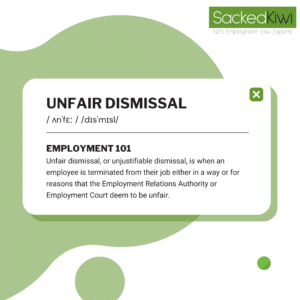
What is unfair dismissal?
Unfair dismissal, or unjustifiable dismissal, is when an employee is terminated from their job either in a way or for reasons that the Employment Relations Authority or Employment Court deem to be unfair.
Unjustifiable dismissal, which is also referred to as unjustified dismissal, wrongful dismissal, unfair termination etc, is a specific grievance that an employee can bring against their former employer if they feel they have been unfairly treated in the termination of their employment.
There are two general basis’ for an unjustifiable dismissal. The first is process and the second is substance (the reason), for an unjustifiable dismissal the employee would need to show just one element to be successful.
The Employer must follow the correct process when dismissing an employee, and if they do not adhere to this then the employee will be deemed to be have been unfairly dismissed. Examples are; not advising the employees employment is at risk, not advising the employee of their right to support or representation, not listening and considering the employees response to the allegations, or even not investigating the issue properly.
Employers often get the 90 day trial period wrong, which leads to procedurally incorrect dismissals.
Generally though the ERA and the Court will look at what a fair and reasonable employer could do in all the circumstances. The rules can change a bit depending on the context and circumstances, like the size and resource of the employer.
The employer must have a valid reason for dismissing an employee also, this is referred to as the substantive justification.
Generally speaking the reason has to be very serious to allow for an employee to be sacked. It is the most severe sanction an employee can adopt so accordingly the reason has to be serious.
The basis for the dismissal has to go to the very heart of the relationship and destroy all trust and confidence. It could be for something clearly serious like theft or assault or dishonesty of course but can also be for ongoing performance issues.
Again an employer still needs to follow the correct process to fairly terminate someone.
Redundancies also need to be adhered to properly from a procedural perspective and the reason must be fair and reasonable.
There are lots of ways an employer can get a dismissal wrong so if you have been dismissed you should always seek advice.
For information about other personal grievances check out our Employment 101 Course where we cover:
- Unjustified disadvantage
- Discrimination
- Sexual Harassment
- And More.
What is the difference between unfair dismissal vs fair dismissal?
The difference between unfair dismissal and fair dismissal lies in the reasons and process behind the termination. Fair dismissal typically occurs when an employer terminates an employee for valid reasons, such as poor performance, misconduct, redundancy, or other legitimate causes based on the terms outlined in the employment contract or established laws.
Understanding the differences can be difficult and if you are unsure if your dismissal was fair or not its important to get legal advice. Our team of experts can provide you with the help you need. Feel free to get in contact with our team for some help. Contact them here!
What is the compensation in New Zealand for unfair dismissal?
In New Zealand the Employment Relations Authority generally handles unjustifiable dismissal claims. If successful the ERA will look to award remedies to the employee. These generally can be; reinstatement, lost wages, compensation and costs.
The amount varies depending on the circumstances of the case and is determined by the Employment Relations Authority (ERA) or by the Employment Court.
Lost wages generally look to compensate an employee for the actual loss of wages for up to a 13 week period after the dismissal. It is possible to apply for beyond this period, but an employee must have been applying for work in this period, or have good reason why they did not.
Compensation for hurt feelings depends on the circumstances and is determined by the Member (The ERA Decision maker) or Judge. Things like length of service, how humiliating the dismissal was and the actual impact suffered are all factors for consideration.
Contribution
If an employee wins an unjustifiable dismissal claim the ERA or Court must consider what part the employee played in the dismissal and assess their contribution.
The Member or Judge must decide if the employee actions were causative and/or blameworthy and if so will discount the amount awarded. This is done by way of a percentage discount. Low level contribution is set at 10-20% and for significant contribution beyond 50%. Sometimes if it is found the employee actions were so bad the ERA or Court may discount the remedies by 100%. This might be for theft or an assault.
Can a contractor claim unfair dismissal?
This has actually become a tricky question.
Only employees can bring a case to the ERA or Employment Court. But defining what an employee is has become much trickier. Even Uber drivers won a case recently determining they were employees.
If a Contractors can show they were actually an employee they can claim an unjustified dismissal grievance.
Sometime there will be an agreement in place. A contract for service is for a contractor and a contract of service is for an employee. But the existence of a contract is not only determining factor.
There are a number of tests that are applied. They are the; Intention Test (what the parties intended at the start of the engagement), the Control Test (what control does the employer have over the employee like set hours), Integration Test (how much of a part of the organisation was the person, like did they have a uniform), Fundamental Test (This looks at things like tax and time sheets).
These tests would be applied, with some having more weight than others but would then provide a true picture if the person was an employee or a contractor. Things like rosters, set hours and ability to work elsewhere and tax are all critical indicators.
Can being made redundant be considered unfair dismissal?
Redundancy can be considered unfair dismissal if it’s not conducted in accordance with legal requirements or fair procedures. Unfair redundancy may occur when an employer fails to offer alternative roles within the company, doesn’t consult with employees, the reasons for the redundancy are not genuine, or unfairly selects individuals for redundancy.
How long after dismissal can I claim unfair dismissal?
In New Zealand, the timeframe for claiming unjustifiable dismissal, also termed wrongful termination or unlawful dismissal or unfair dismissal, is generally within 90 days after the date of dismissal.
The 90 day limit needs to have been included within the Individual Employment Agreement and after 90 days the employee which would then mean the employee must bring the personal grievance 90 days after they are dismissed. This applies to any grievance including unjustified disadvantage but not sexual harassment which is 12 months.
There are exceptions to the 90 day limit for raising a grievance like is you asked someone to raise the grievance for you, were so unwell you could not bring the claim or it is not in your employment agreement. You can ask for a reason for your dismissal and if your employer does not provide this then this also null in voids the 90 day limit for a grievance.
If you are out of 90 days you can ask your employer to allow the grievance to be raised, but they do not have to.
Understanding the nuances between fair and unfair dismissal is essential for both employers and employees to ensure compliance with employment laws and fair treatment within the workplace. Seeking legal advice in cases of dismissal is advisable to ascertain rights, obligations, and potential avenues for resolution. Get in touch with our Team of Legal Experts. Contact them here!
Legal Disclaimer: The content posted on the Sacked Kiwis website should not be considered or relied upon as legal advice or opinion. The information presented here is not intended to serve as legal guidance. Over time, laws and regulations evolve, potentially altering the accuracy of previously shared information. Updates in jurisprudence or legislation, which could happen without immediate notice, may render the legal information on this platform outdated or obsolete.
Should you need employment advice, please don’t hesitate to contact us through our toll-free hotline.

